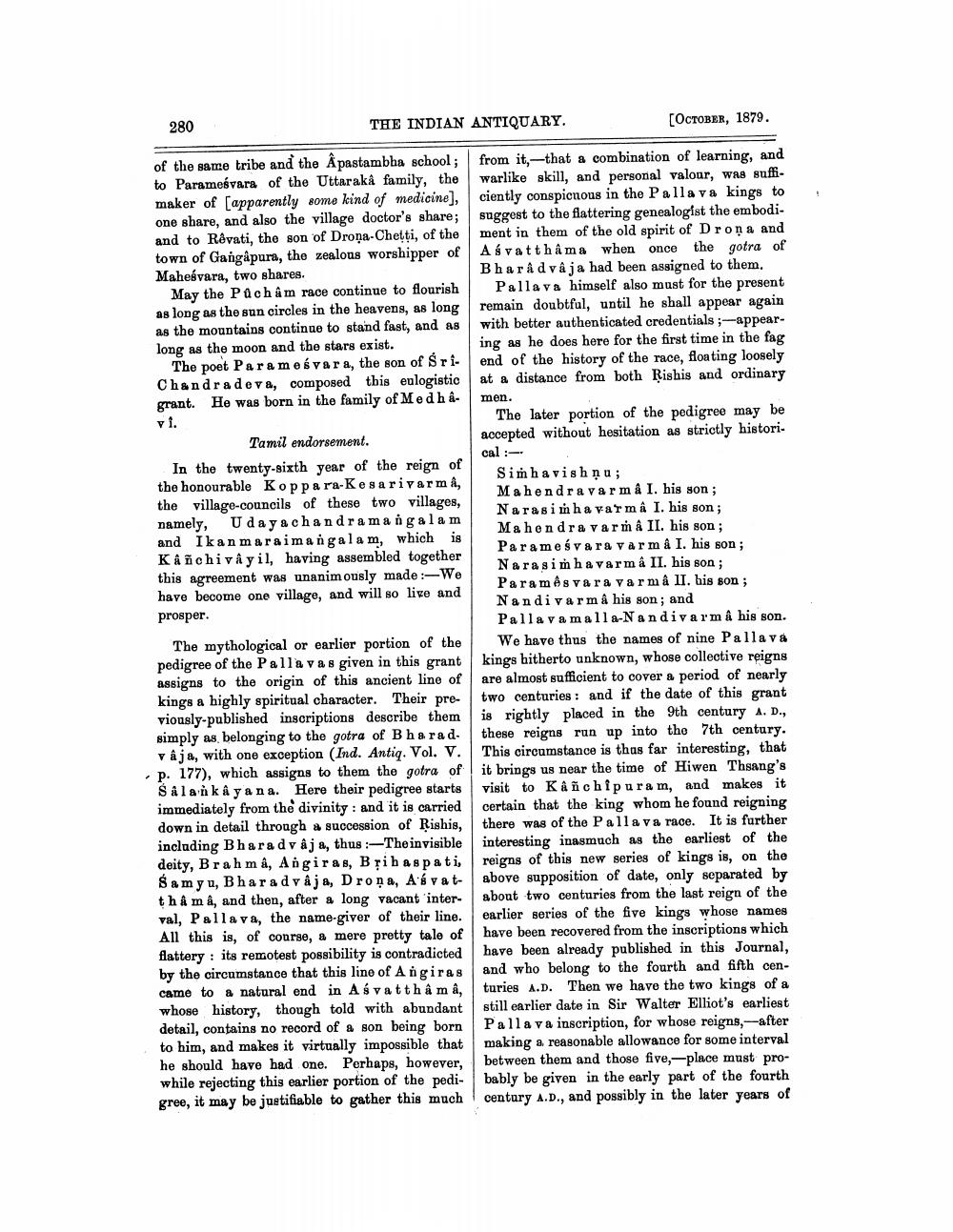________________
THE INDIAN ANTIQUARY.
280
of the same tribe and the Apastambha school; to Paramesvara of the Uttarakâ family, the maker of [apparently some kind of medicine], one share, and also the village doctor's share; and to Rêvati, the son of Drona-Chetti, of the town of Gangapura, the zealous worshipper of Maheśvara, two shares.
May the Puch âm race continue to flourish as long as the sun circles in the heavens, as long as the mountains continue to stand fast, and as long as the moon and the stars exist.
The poet Paramesvara, the son of SriChandradeva, composed this eulogistic grant. He was born in the family of Med hâvi.
Tamil endorsement.
In the twenty-sixth year of the reign of the honourable Koppara-Kesarivarmâ, the village-councils of these two villages, namely, Udayachandramangalam and Ikanmaraimangalam, which is Kanchivayil, having assembled together this agreement was unanimously made:-We have become one village, and will so live and prosper.
[OCTOBER, 1879.
from it, that a combination of learning, and warlike skill, and personal valour, was sufficiently conspicuous in the Pallava kings to suggest to the flattering genealogist the embodiment in them of the old spirit of Drona and Asvatthâma when once the gotra of Bharadvaja had been assigned to them.
The mythological or earlier portion of the pedigree of the Pallavas given in this grant assigns to the origin of this ancient line of kings a highly spiritual character. Their previously-published inscriptions describe them. simply as belonging to the gotra of Bharadv âja, with one exception (Ind. Antiq. Vol. V. p. 177), which assigns to them the gotra of Salakayana. Here their pedigree starts immediately from the divinity: and it is carried down in detail through a succession of Rishis, including Bharadvaja, thus:-The invisible deity, Brahmâ, Angiras, Brihaspati, Samyu, Bharadvaja, Drona, Asvatthâm â, and then, after a long vacant interval, Pallava, the name-giver of their line. All this is, of course, a mere pretty tale of flattery: its remotest possibility is contradicted by the circumstance that this line of Angiras came to a natural end in Asvatthâm â, whose history, though told with abundant detail, contains no record of a son being born to him, and makes it virtually impossible that he should have had one. Perhaps, however, while rejecting this earlier portion of the pedigree, it may be justifiable to gather this much
Pallava himself also must for the present remain doubtful, until he shall appear again with better authenticated credentials;-appearing as he does here for the first time in the fag end of the history of the race, floating loosely at a distance from both Rishis and ordinary
men.
The later portion of the pedigree may be accepted without hesitation as strictly historical:
Simhavishnu;
Mahendravar mâ I. his son; Narasimha varma I. his son; Mahendra varm â II. his son; Paramesvara varm â I. his son; Narasimha varm â II. his son; Paramêsvara varmâ II. his son ; Nandivarmâ his son; and Pallavamalla-Nandivarmâ his son. We have thus the names of nine Pallava kings hitherto unknown, whose collective reigns are almost sufficient to cover a period of nearly two centuries and if the date of this grant is rightly placed in the 9th century A. D., these reigns run up into the 7th century. This circumstance is thus far interesting, that it brings us near the time of Hiwen Thsang's visit to Kanchipuram, and makes it certain that the king whom he found reigning there was of the Pallava race. It is further interesting inasmuch as the earliest of the reigns of this new series of kings is, on the above supposition of date, only separated by about two centuries from the last reign of the earlier series of the five kings whose names have been recovered from the inscriptions which have been already published in this Journal, and who belong to the fourth and fifth centuries A.D. Then we have the two kings of a still earlier date in Sir Walter Elliot's earliest Palla va inscription, for whose reigns,-after making a reasonable allowance for some interval between them and those five,-place must probably be given in the early part of the fourth century A.D., and possibly in the later years of




